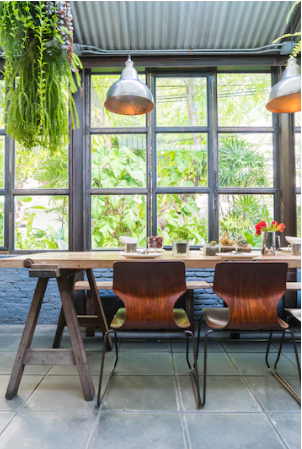When it comes to enhancing the aesthetic appeal and functionality of your home or office, choosing the right window glass is crucial. Frosted and textured glass options have gained popularity for their ability to add privacy, style, and even energy efficiency to spaces. In this comprehensive guide, we’ll delve into the world of frosted and textured window glass, exploring its various types, benefits, applications, and considerations for installation.
Understanding Frosted Glass:
Frosted glass, alternatively referred to as obscured glass, is a glass variety subjected to treatment aimed at producing a translucent surface. This effect is achieved through processes such as sandblasting, acid etching, or applying a frosted film. The result is a smooth, matte finish that diffuses light while maintaining privacy.
Types of Frosted Glass:
Sandblasted Frosted Glass: This type of frosted glass is created by blasting sand or abrasive materials onto the surface of the glass at high pressure. The process removes small portions of the glass, leaving behind a frosted appearance.
Acid-Etched Frosted Glass: Acid etching involves applying a chemical solution to the glass surface, which reacts with the glass to create a frosted effect. This method allows for precise control over the degree of opacity and design intricacies.
Frosted Film: Frosted film is a cost-effective and versatile option for achieving a frosted look. It involves applying a self-adhesive film to the glass surface, which can be easily customized with various patterns and designs.
Benefits of Frosted Glass:
Frosted glass offers several benefits that make it a popular choice for both residential and commercial applications:
Privacy: Frosted glass obscures visibility while still allowing natural light to filter through, making it ideal for areas where privacy is desired, such as bathrooms, conference rooms, and entryways.
Aesthetic Appeal: The subtle, elegant appearance of frosted glass adds a touch of sophistication to any space, complementing a wide range of interior design styles.
Light Diffusion: Frosted glass diffuses light evenly, reducing glare and creating a soft, ambient illumination that enhances the atmosphere of a room.
Versatility: From shower enclosures to office partitions, frosted glass can be used in various applications to achieve both functional and decorative purposes.
Exploring Textured Glass:
Textured glass, as the name suggests, features patterns or textures on its surface, adding visual interest and depth. These textures can range from subtle to bold, creating unique effects that enhance the overall aesthetic of a space.
Types of Textured Glass:
Seeded Glass: Seeded glass is characterized by the presence of small air bubbles or “seeds” trapped within the glass during the manufacturing process. This creates a charming, vintage-inspired look reminiscent of antique glassware.
Reeded Glass: Reeded glass features vertical ridges or “reeds” running parallel across the surface, adding a sense of texture and dimension. This type of glass is often used in cabinets, doors, and partitions.
Fluted Glass: Similar to reeded glass, fluted glass features vertical grooves that create a ribbed effect. This elegant texture adds a touch of sophistication to any space and can be customized to suit various design preferences.
Benefits of Textured Glass:
Textured glass offers a range of benefits that make it a popular choice for both residential and commercial projects:
Enhanced Privacy: The intricate patterns and textures of textured glass obscure visibility while still allowing light to pass through, making it an excellent choice for areas where privacy is desired.
Visual Interest: Textured glass adds visual depth and complexity to windows, doors, and other glass surfaces, creating a focal point that enhances the overall aesthetic of a room.
Diffused Light: Like frosted glass, textured glass diffuses light evenly, reducing glare and creating a soft, inviting ambiance that promotes relaxation and productivity.
Customization Options: With a wide range of patterns and textures available, textured glass can be customized to suit any design style or preference, allowing for endless creative possibilities.
Considerations for Installation:
Before selecting frosted or textured glass for your project, there are several important factors to consider:
Location: Consider the location of the glass installation and the level of privacy or light diffusion required for that specific area.
Maintenance: Some types of frosted and textured glass may require more maintenance than others. Be sure to inquire about cleaning and maintenance recommendations before making your decision.
Budget: While frosted and textured glass can add value and style to your space, they may also come with a higher price tag compared to standard clear glass options. Determine your budget and explore cost-effective alternatives if necessary.
Installation Requirements: Depending on the type of glass and the complexity of the installation, professional installation may be necessary to ensure optimal results and longevity.
Applications of Frosted and Textured Glass:
Frosted and textured glass can be used in a variety of residential and commercial applications, including:
Windows: Frosted and textured glass windows provide privacy without sacrificing natural light, making them ideal for bedrooms, bathrooms, and offices.
Doors: Whether used for interior doors, entry doors, or shower doors, frosted and textured glass adds style and functionality to any space.
Partitions: Frosted and textured glass partitions create separation without closing off areas entirely, making them perfect for open-concept living spaces, offices, and retail environments.
Cabinetry: Textured glass cabinet doors add visual interest to kitchens, bathrooms, and display cabinets, while frosted glass panels conceal the clutter while still allowing contents to be visible.
Conclusion:
Frosted and textured glass choices provide a flexible and chic answer to improve the visual attractiveness and practicality of any area. Whether you’re looking to add privacy, diffuse light, or elevate the overall design, frosted and textured glass provides endless possibilities for customization and creativity. By understanding the different types, benefits, applications, and considerations for the installation of frosted and textured glass, you can make informed decisions to create the perfect atmosphere for your home or business.





